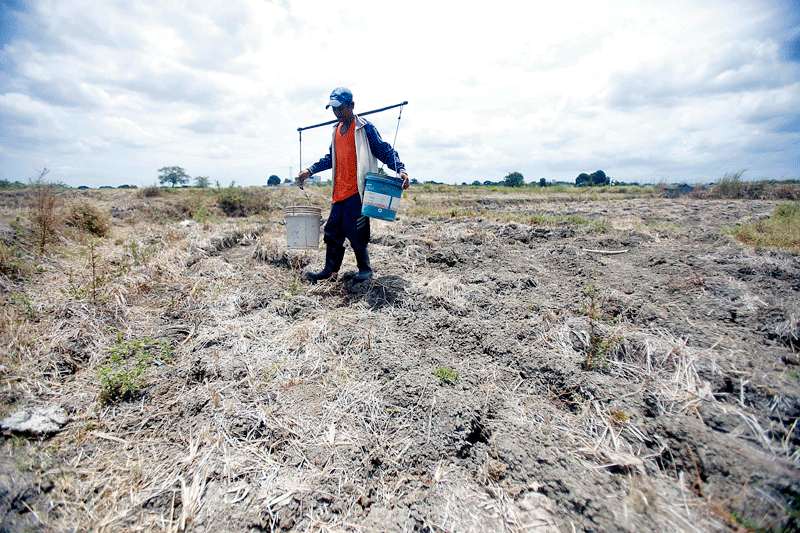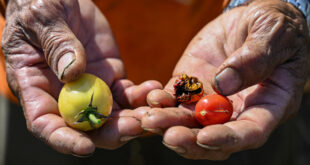
As the El Niño phenomenon continues to devastate the country, the Department of Agriculture (DA) said its impact on the Philippines’ agriculture sector has surged to P357.4 million, affecting nearly 8,000 farmers.
As of February 25, the DA said the areas hit by El Niño are the Ilocos Region, MIMAROPA (Mindoro, Marinduque, Romblon, and Palawan), Western Visayas, and Zamboanga Peninsula
Of the said damage, the agriculture department said 79.54 percent is from rice; 16.98 percent came from corn; and 3.47 percent is from high-value crops (HVC).
The DA stated that the 5,011 hectares of rice that are damaged represent 0.52 percent of the entire target planted area, and the 11,480 metric tons (MT) production loss represents around 0.12 percent of the projected output for the dry cropping season this 2024.
In terms of corn, the DA reported that the dry spell has affected 1,263 hectares or 0.11 percent of the total target area planted and that the 2,897 MT output loss is equivalent to 0.06 percent of the target production for the 2024 dry cropping season.
“Potential production losses from 6,523 hectares affected by the dry spell are estimated at 11,480 metric tons for palay, 2,897 MT for corn, and 225 MT for high-value crops,” the agency said.
The agriculture department noted that most of the damage and losses on rice, corn, and HVC are in their reproductive stage.
According to the DA, hybrid rice seeds have been distributed to non-vulnerable areas in Western Visayas for maximization of production to compensate for the losses.
The agency said it will also provide various vegetable seeds in Western Visayas and Ilocos Region.
High-value crops (including peanuts, legumes, and other crops that require less water) are being procured for Region IX and given to farmers who choose to switch to other crops, the DA stated.
The agriculture department said affected regional field offices will verify areas affected by drought to ascertain if installing Shallow Tube Wells (STWs) is feasible.
“However, there are no programmed funds available for STWs, particularly in rainfed areas in Region IX,” it noted.
The DA added that water sources for irrigation in affected areas in Region VI rely on tributaries that are currently drying up due to drought.
“List of affected farmers will be endorsed to the Department of Social Welfare and Development (DSWD) and Department of Labor and Employment (DOLE) for other forms of assistance, including financial support.”
On January 26, Agriculture spokesperson Assistant Secretary Arnel de Mesa said they are hopeful that the country’s agricultural sector can still produce 20 million MT of palay this year despite the threat of El Niño.
The agriculture department is banking on government measures to mitigate the impact of El Niño.
The spokesperson said the agency’s primary water management interventions include the distribution of small-scale irrigation projects and solar irrigation systems to areas in the tail-end of the irrigation systems and other areas having difficulty accessing water.
He added that the agriculture department is conducting information dissemination in El Niño affected areas.
During a meeting of Task Force El Niño on February 12, Agriculture Assistant Secretary for Operations U-Nichols Manalo said the government will implement “Alternate Wetting and Drying” which uses less water for farming, and “Quick Turn Around” or QTA which allows immediate rice replanting right after harvest.
He said AWD is a water-saving technique that rice farmers can implement to reduce their water use in irrigated fields.
QTA, on the other hand, is a method in which all rice farmers replant immediately after harvest rather than waiting for the months of the following planting season to begin.
Manalo stated that almost one million farmers have been contacted by the agriculture department to install water-saving technology in about 15,000 hectares of rice areas.
The DA seeks to implement the quick-turn-around strategy on more than 26,000 hectares.
Such measures, the agency said, were implemented in compliance with President Marcos’ Executive Order (EO) No. 53 which orders the government to streamline, reactivate, and reconstitute the old El Niño task forces under EO No. 16 (s. 2001) and Memorandum Order No. 38 (s. 2019). The EO was signed by the President last Jan. 19.
The aforementioned Executive Order mandates that the task group create a thorough plan for El Niño and La Niña readiness and recovery, to offer “systematic, holistic, and results-driven interventions” to help the public deal with and lessen their potentially catastrophic impacts. — Jel Santos
*****
Credit belongs to: www.mb.com.ph
 Atin Ito First Filipino Community Newspaper in Ontario
Atin Ito First Filipino Community Newspaper in Ontario






